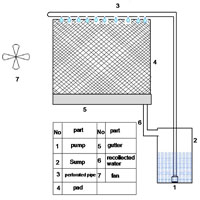Effect of pad water flow rate on evaporative cooling system efficiency in laying hen housing

Published: 23 December 2020
Abstract Views: 2057
PDF: 702
HTML: 1656
HTML: 1656
Publisher's note
All claims expressed in this article are solely those of the authors and do not necessarily represent those of their affiliated organizations, or those of the publisher, the editors and the reviewers. Any product that may be evaluated in this article or claim that may be made by its manufacturer is not guaranteed or endorsed by the publisher.
All claims expressed in this article are solely those of the authors and do not necessarily represent those of their affiliated organizations, or those of the publisher, the editors and the reviewers. Any product that may be evaluated in this article or claim that may be made by its manufacturer is not guaranteed or endorsed by the publisher.
Similar Articles
- Enrico Antonio Chiaradia, Arianna Facchi, Olfa Gharsallah, Marco Romani, Gian Battista Bischetti, Claudio Gandolfi, Water balance of rice plots under three different cultivation methods: first season results , Journal of Agricultural Engineering: Vol. 44 No. s2 (2013): Proceedings of the 10th Conference of the Italian Society of Agricultural Engineering
- Eleonora Iaccheri, Chiara Cevoli, Santina Romani, Marco Dalla Rosa, Giovanni Molari, Angelo Fabbri, Simple and efficient approach for shelf-life test on frozen spinach and parsley , Journal of Agricultural Engineering: Vol. 52 No. 3 (2021)
- Celeste Righi Ricco, Alberto Finzi, Viviana Guido, Elisabetta Riva, Omar Ferrari, Giorgio Provolo , Evaluation of ammonia emissions from filtration of digestate used for fertigation , Journal of Agricultural Engineering: Vol. 52 No. 3 (2021)
- Qazeem Opeyemi Ogunlowo, Wook Ho Na, Anis Rabiu, Misbaudeen Aderemi Adesanya, Timothy Denen Akpenpuun, Hyeon Tae Kim, Hyun Woo Lee, Effect of envelope characteristics on the accuracy of discretised greenhouse model in TRNSYS , Journal of Agricultural Engineering: Vol. 53 No. 3 (2022)
- Alvaro Marucci, Danilo Monarca, Massimo Cecchini, Andrea Colantoni, Andrea Cappuccini, Analysis of internal shading degree to a prototype of dynamics photovoltaic greenhouse through simulation software , Journal of Agricultural Engineering: Vol. 46 No. 4 (2015)
- Wenjun Wang, Sihao Zhang, Jingyu Li, Pengfei Zhang, Yulong Chen, Effects of the twin-row planter with subsoiling on soybean growth and yield in northern China , Journal of Agricultural Engineering: Vol. 53 No. 3 (2022)
- Alessio Cislaghi, Gian Battista Bischetti, Best practices in post-flood surveys: The study case of Pioverna torrent , Journal of Agricultural Engineering: Vol. 53 No. 2 (2022)
- Giovanni Russo, Giuseppe Verdiani, The health risk of the agricultural production in potentially contaminated sites: an environmental-health risk analysis , Journal of Agricultural Engineering: Vol. 43 No. 3 (2012)
- Xingbo Hu, Tian Xia, Leidong Yang, Fangming Wu, Ying Fan, Yinghong Tian, 3D modeling and volume measurement of bulk grains stored in large warehouses using bi-temporal multi-site terrestrial laser scanning data , Journal of Agricultural Engineering: Vol. 55 No. 1 (2024)
- Elena Bresci, Antonio Giacomin, Federico Preti, Experiences of improving water access in rural areas in Guatemala , Journal of Agricultural Engineering: Vol. 44 No. s2 (2013): Proceedings of the 10th Conference of the Italian Society of Agricultural Engineering
<< < 9 10 11 12 13 14 15 16 17 18 > >>
You may also start an advanced similarity search for this article.

 https://doi.org/10.4081/jae.2020.1051
https://doi.org/10.4081/jae.2020.1051






